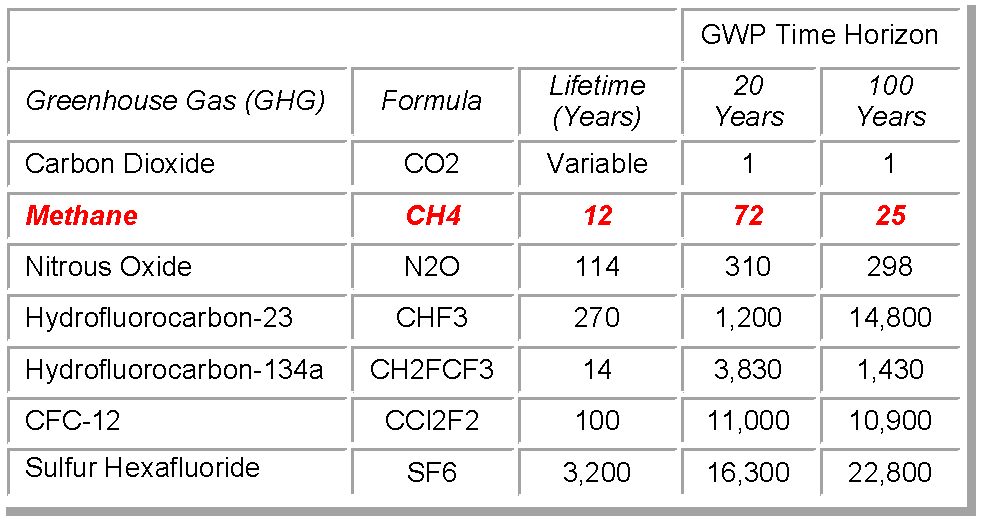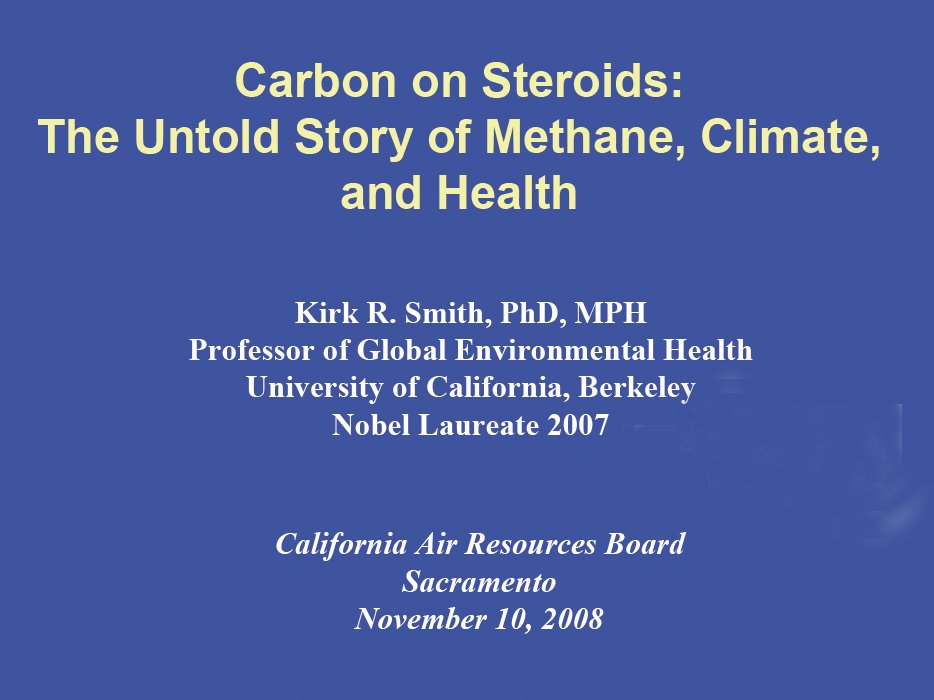Methane vs. CO2 Global Warming Potential
Methane and Carbon Dioxide - CH4 and CO2
105 times. Level of heat trapping potency that methane is greater than carbon
dioxide over a 20-year time frame according to NASA research. “But
[Robert Howarth, a professor of ecology and environmental biology at
Cornell University] and company took things even further, incorporating
data from Drew T. Shindell at NASA’s Goddard Institute for Space
Studies, who published a study in 2009 in the journal Science that
suggested that the interaction of methane with certain atmospheric
aerosols might well amplify the global warming potential of methane,
rendering it up to 105 times more potent than carbon dioxide in the
20-year time frame. Although the 100-year time horizon is more commonly
used by climate scientists, Mr. Howarth relies on the shorter
time-horizon, which would greatly intensify the impact of leaking
methane on climate. Combining that with the novel methane leakage
estimates at various points along the production and transmission life
cycles, he and his co-authors were able to push the climate impact, per
unit of energy, of unconventional natural gas industry well beyond that
of the perennial environmental and climate demon, coal." (Tom Zeller Jr., “Methane Losses Stir Debate on Natural Gas,” The New York Times, April 12, 2011
72 times. Methane has a global warming potential 72 times greater than carbon dioxide over a 20 year period. Compared with carbon dioxide, methane has a high global warming potential of 72 (calculated over a period of 20 years) or 25 (for a time period of 100 years). (Intergovernmental Panel on Climate Change - IPCC - "Climate Change 2007: The Physical Science Basis - Summary for Policymakers," Fourth Assessment Report -FAR, Working Group 1, Chapter 2, IPCC Secretariat, Geneva, Switzerland, February 2007, p. 212)
72 times. Over a 20-year period, one pound of methane traps as much heat as at least 72 lbs. of CO2. “Methane is a far more powerful greenhouse gas than carbon dioxide, though it doesn’t last nearly as long in the atmosphere. Still, over a 20-year period, one pound of it traps as much heat as at least 72 pounds of carbon dioxide. Its potency declines, but even after a century, it is at least 25 times as powerful as carbon dioxide. When burned, natural gas emits half the carbon dioxide of coal, but methane leakage eviscerates this advantage because of its heat-trapping power.” (Anthony R. Ingraffea, “Gangplank to a Warm Future,” The New York Times, July 28, 2013)
72 times. Over 20 years, emission of 1 ton of methane has the same climatic impact as the emission of 72 tons of carbon dioxide. "After Carbon Dioxide, Methane is the next most important GHG [greenhouse gas], because it has high capacity to absorb infrared radiation and is relatively abundant. [T]he observed lifetime of methane, in today’s atmosphere, is on average 12 years. Methane has a GWP [global warming potential] of 72 over a 20 year period, meaning that over this time period, the emission of 1 ton of methane will have the same climate impact as the emission of 72 tons of carbon dioxide, or in other words methane is 72 times stronger than carbon dioxide. When looking at a 100 year period of time, however, the emission of 1 ton of methane has the same climate impact as the emission of 25 tons of carbon dioxide." Energy + Environment Foundation, info@eeocw.org, Global Warming Potentials, Energy + Environment OpenCourseWare, Washington, DC, 2008, p. 3)
Gangplank to the future. "As a longtime oil and gas engineer who helped develop shale fracking techniques for the Energy Department, I can assure you that [natural] gas is not ‘clean.’
Because of leaks of methane, the main component of natural gas, the gas extracted from shale deposits is not a 'bridge' to a renewable energy future — it’s a gangplank to more warming and away from clean energy investments."
Anthony R. Ingraffea
Dept. of Civil and Environmental Engineering
Cornell University, Ithaca, New York
64 times. Number of times more potent that methane is compared to carbon dioxide as a heat-trapping gas. “For the same volume, methane is 64 times more potent as a heat-trapping gas than carbon dioxide, and there is a lot of it.” Methane compared to carbon dioxide. (Ian Hoffman, Staff Writer, “Global warming could trigger methane release,” The Oakland Tribune, Oakland, California, August 29, 2006 reporting findings in T. M. Hill, J. P. Kennett, D. L. Valentine, Z. Yang, C. M. Reddy, R. K. Nelson, R. J. Behl, C. Robert, and L. Beaufort, “Climatically driven emissions of hydrocarbons from marine sediments during deglaciation,” published online before print August 30, 2006, doi: 10.1073/pnas.0601304103 and published in print Proceedings of the National Academy of Sciences PNAS September 12, 2006 vol. 103 no. 37 13570-13574 pp. 13570–13574)
30 times. Number of times more potent methane is than CO2 in terms of heat-trapping potential. “Methane is a greenhouse gas more than 30 times more potent than carbon dioxide.” How does methane compare to carbon dioxide? (“Methane Releases From Arctic Shelf May Be Much Larger and Faster Than Anticipated,” Press Release 10-036, National Science Foundation, March 4, 2010)
25 times. Methane GWP potency compared to carbon dioxide over a 100 year period.
“Methane is a relatively potent greenhouse gas. Compared with carbon
dioxide, it has a high global warming potential of 72 (calculated over a
period of 20 years) or 25 (for a time period of 100 years).
(Intergovernmental Panel on Climate Change - IPCC - "Climate Change 2007: The Physical Science Basis - Summary for Policymakers," Fourth Assessment Report, Working Group 1, Chapter 2, IPCC Secretariat, Geneva, Switzerland, February 2007, p. 212)
23 times. Methane has about 23 times the global warming potential of carbon dioxide when it is released into the atmosphere.
“Methane (CH4) . . . is the simplest hydrocarbon, and is the primary
component of the natural gas that we burn for energy. Methane is also an
important greenhouse gas, it has about 23 times the global warming
potential of carbon dioxide when it is released into the atmosphere.
There are many sources of methane. Some methane comes from human
activities, for example, landfills, rice cultivation, and ruminant farm
animals (like cows) are all large methane sources. Other large methane
sources, like the ocean and wetlands, are natural.” (Monica Heintz,
University of California, Santa Barbara, “Methane in the Ocean,” Ocean Explorer, ,” National Oceanic and Atmospheric Administration, Washington, DC, revised August 25, 2010)
21 times. Methane is about 21 times more powerful at warming the atmosphere than carbon dioxide.
“Methane (CH4) is a principal component of natural gas. It is also
formed and released to the atmosphere by biological processes occurring
in anaerobic environments. Once in the atmosphere, methane absorbs
terrestrial infrared radiation that would otherwise escape to space.
This property can contribute to the warming of the atmosphere, which is
why methane is a greenhouse gas. Methane is about 21 times more
powerful at warming the atmosphere than carbon dioxide (CO2) by weight. .
. Methane's chemical lifetime in the atmosphere is approximately 12
years. Methane’s relatively short atmospheric lifetime, coupled with its
potency as a greenhouse gas, makes it a candidate for mitigating global
warming over the near-term (i.e., next 25 years or so).” (U.S. EPA, Science - Greenhouse Gas Properties,
Climate Change Division – 202-343-9990, Office of Atmospheric Programs,
U.S. Environmental Protection Agency, Washington, DC, June 22, 2010)
20 Times. Global warming potential of methane compared to carbon dioxide.
“In the ongoing debate over global warming, climatologists usually peg
carbon dioxide as the most dangerous of the atmosphere's heat- trapping
gases. But methane, a greenhouse gas 20 times more potent than carbon
dioxide, might be even more problematic. According to Tessa Hill, a
geologist at the University of California, Davis, more methane is
released into the atmosphere from ocean deposits during periods of
warming than previously thought. This expelled methane increases
temperatures and releases more methane, creating a positive feedback
loop.” (Elizabeth Svoboda, “Global Warming Feedback Loop Caused by Methane, Scientists Say,” National Geographic News, August 29, 2006 reporting findings in Tessa M. Hill - tmhill@ucdavis.edu, J. P. Kennett, D. L. Valentine, Z. Yang, C. M. Reddy, R. K. Nelson, R. J. Behl, C. Robert, and L. Beaufort, “Climatically driven emissions of hydrocarbons from marine sediments during deglaciation,” published online before print August 30, 2006, doi: 10.1073/pnas.0601304103 and published in print Proceedings of the National Academy of Sciences, PNAS vol. 103 no. 37 13570-13574, September 12, 2006, pp. 13570–13574)
Methane Heat-Trapping Potential Compared to CO2
___________________________________________________
Are policymakers failing to pay sufficient attention to the climate instability risks of methane?
Focusing disproportionately on controlling those greenhouse gases like carbon dioxide that produce warming impacts in the distant future at the expense of not controlling those gases like methane that inflict climate disruption impacts in the immediate future, could yield a harvest of regrets.
In the words of Nobel Laureate Dr. Kirk R. Smith, doing so engenders the undesirable result of "spending more money to protect people thousands of years into the future and ignoring the needs of ourselves and our children." (1)
___________________________________________________
Increases in Natural Gas Production
Produce Increases in Methane Emissions
See accompanying PowerPoint presentation by Robert W. Howarth, Renee Santoro and Anthony Ingraffea, Developing Natural Gas in the Marcellus and other Shale Formations is likely to Aggravate Global Warming,
Department of Ecology & Evolutionary Biology and School of Civil and
Environmental Engineering, Cornell University, Ithaca, New York, March
15, 2011
Climate Impact Per Unit of Energy
Natural Gas vs. Coal Emissions
Comparison of greenhouse gas emissions from shale gas with low and high estimates of fugitive methane emissions, conventional natural gas with low and high estimates of fugitive methane emissions, surface-mined coal, deep-mined coal, and diesel oil. Hydraulic fracking. Source: Climatic Change 2011, Robert W. Howarth, Renee Santoro, Anthony Ingraffea, "Methane and the greenhouse-gas footprint of natural gas from shale formations," Climatic Change, March 13, 2011.
___________________________________________________
Coal mines have traditionally vented methane into the atmosphere.
Coal mine ventilation systems are the biggest source of methane emissions, accounting for 81 billion cubic feet, or 51% of coal mine methane emissions in 2006. (2)
Kris Maher
The Wall Street Journal
___________________________________________________
(1) Kirk R. Smith, PhD, Nobel
Laureate, "Carbon on Steroids, The Untold Story of Methane, Climate, and Health," PowerPoint presentation to the California Air Resources Board (CARB), Sacramento, California, November 10, 2008, Slide 18. See video of presentation.
(2) Kris Maher, “Mining Project Aims to Capture Methane,” The Wall Street Journal, New York, June 2, 2010
_________________________________________________________
Arctic Global Warming | Wildfires | Climate Change Cost | Kilimanjaro Melting | Heat Waves Global Warming | Energy Workforce Shortages | Water Shortages
Permafrost | Global Warming Sea Levels Rising | Sea Level Rise Maps | Underestimates | Global Warming Deaths


